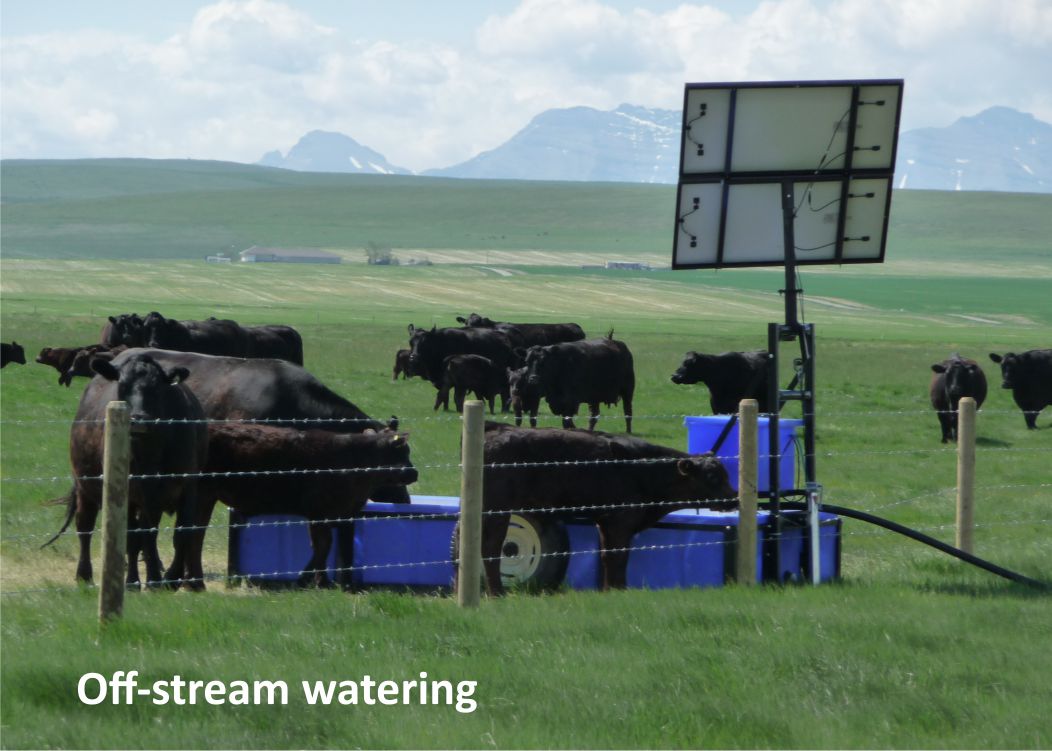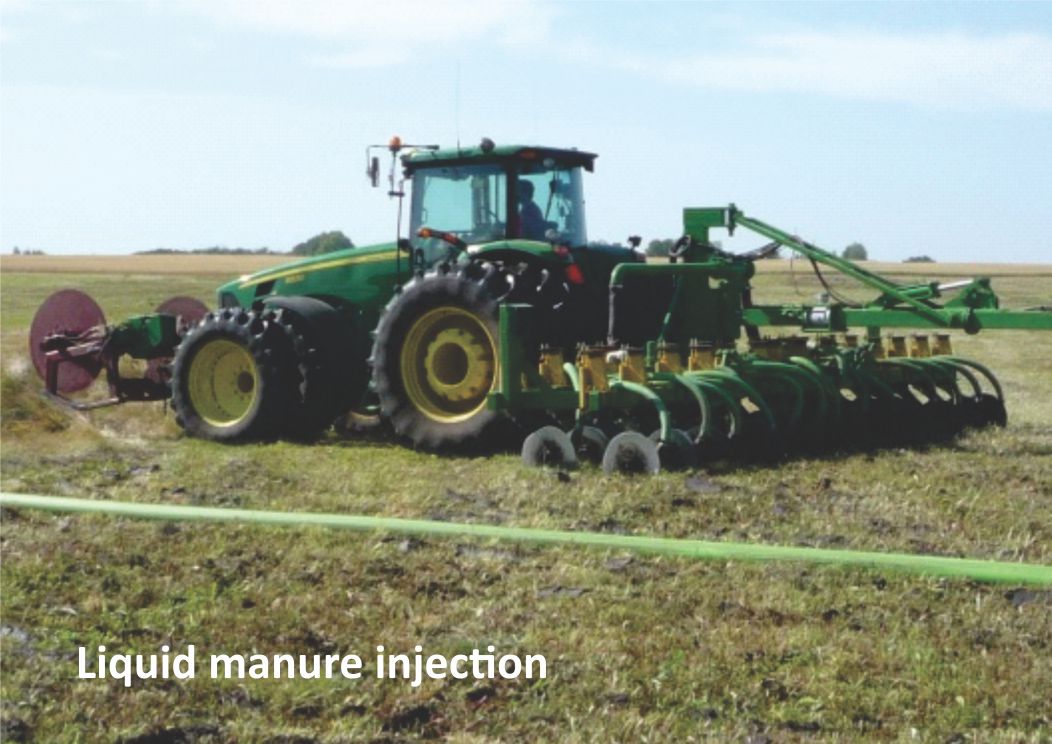| | The project | Field study | Modelling study | Conclusions | Scientific recommendations | Project partners | Publications | For more information
The Project
Nutrients and the management of nutrients are critical for crop and livestock production. However, when not managed effectively, nutrients from agricultural systems can be lost to surface water bodies resulting in reduced water quality. Many beneficial management practices (BMPs) have been promoted and adopted to improve environmental sustainability of agricultural practices in the province, though there is limited information about the effectiveness of BMPs under Alberta conditions.
To help address this information gap, Alberta Agriculture and Forestry and partners carried out a six-year project (2006 to 2012) to evaluate the environmental effectiveness and the economic implications of BMPs in Alberta. The project included field and modelling studies. Two watersheds in Alberta were selected: Indianfarm Creek Watershed (14,145 hectares) and Whelp Creek Sub-watershed (5056 hectares). These two watersheds were chosen for their diversity of farming operations, landscape, climate, and location. In addition, two irrigated field sites (65 and 130 hectares) with a history of cattle manure application were selected in the Battersea Drain and Lower Little Bow watersheds.
 Field Study Field Study
The project design included a two- to four-year pre-BMP monitoring period followed by a two- to four-year post-BMP monitoring period. The BMPs were designed and implemented in cooperation with the producers. The BMPs implemented at specific sites involved cattle management (ten sites), manure nutrient management (eight sites), or surface-water management (four sites). Surface water quality was monitored for nutrients (nitrogen and phosphorus), sediment, and bacteria (Escherichia coli) as the main environmental indicators. Soil nutrient status, riparian quality, and rangeland quality were additional indicators used at some BMP sites.
Modelling Study
The Comprehensive Economic and Environmental Optimization Tool (CEEOT) was used as the model. The CEEOT model was first applied to the Indianfarm Creek and Whelp Creek watersheds and the Lower Little Bow Field. Then the model was used on a larger area (1.2 million hectares) in the central portion of the Red Deer River Watershed. A variety of the BMP scenarios were modelled and compared.
Conclusions
Field Study
- Development of a watershed approach to BMP implementation required the collective support of area residents and ongoing communication to share concerns and develop solutions—it took time and trust building.
 The mitigation of environmental water quality concerns required the implementation of site-specific suites of BMPs. The mitigation of environmental water quality concerns required the implementation of site-specific suites of BMPs.
- The addition of manure to the land by mechanical application will increase total nitrogen (TN) and total phosphorus (TP) concentrations in runoff water compared to non-manured or pasture sites.
- Almost all of the BMP suites implemented at each site were effective at significantly improving water quality for TN, TP, total suspended solids (TSS), and/or Escherichia coli (E. coli) concentrations at the edge-of-field or immediately downstream.
- The location or scale of water quality measurement is important when evaluating the efficacy of BMPs as well as adherence to water quality guidelines or objectives.
- The costs of BMPs varied, but generally, BMPs for extensive livestock were less costly than BMPs associated with intensive livestock.
- Phosphorus reduction will require decades of mitigation efforts in fields with a long-term accumulation of soil P from manure application, and will be costly to implement.
- For irrigated fields with high soil nutrient concentrations from manure applications, BMPs that deal with the source and transport of nutrients are required.
- The BMP Project watersheds were representative of the Grassland and Parkland natural regions, and the results should inform future BMP approaches and recommendations throughout much of Alberta’s agricultural regions.
- As expected, the relatively few BMPs implemented in each of the project watersheds did not measurably improve water quality at the outlet.
- Shallow groundwater conditions must be considered in the design and assessment of BMPs.
Modelling Study
- The CEEOT model was able to simulate the environmental and economic impacts of suites or scenarios of BMPs at the farm and watershed scales.
- The Farm-level Economic Model, which assessed the annual economic impact of BMPs on farm profits for 30 to 35 years, showed that financial impacts were greater in some years than others.
- The model BMP scenario performance was validated as it confirmed several conclusions from the field study.
- Although the model simulated that riparian and cow-calf BMPs resulted in significant reductions of sediment and nutrient losses, the environmental outcome may not be significant, depending on the watershed.
- All BMP Project watershed model scenarios resulted in negative net returns either from a decline in revenues or an increase in cost.
- For the Red Deer River study area, most BMP scenarios were successful at reducing nutrient losses from the farm or the study area as a whole, and usually at a financial cost to the producer.
- Water quality improvements were more easily demonstrated at the edge-of-field or at the outlet of relatively small watersheds than for a larger watershed like the Red Deer River study area.
- The most environmentally effective BMPs varied among the study areas and this highlights the need for several BMP options in order to address the diversity of Alberta's landscape and agriculture.
- The model predicted that P-based manure application limits were more effective in reducing the TP at the edge-of-field than at the watershed outlets.
- Four of the most environmentally effective scenarios modelled in the Red Deer River study area included P-based manure management, with varied impacts on farm economics.
- Implementing P-based manure management in the Red Deer River study area would require increased manure hauling as more manure would need to be transported from a greater number of farms.
- Targeting critical source areas for BMP implementation may increase the chance of positive effects on water quality.
Scientific Recommendations
- Develop specific water-quality objectives for key nutrients such as TN and TP in agricultural watershed streams that reflect the naturally nutrient-rich prairie soils.
- A key preventative plan to protect water quality is to avoid the build-up of soil nutrients on agricultural land.
- Critical source areas should be mapped and defined for all agricultural watersheds in Alberta.
- Suites of agricultural BMPs should be implemented within watersheds in order to achieve measurable downstream water quality improvement.
- Alberta should continue to assess the cumulative and long-term effectiveness of BMPs to mitigate the impacts of agricultural management on water quality at the watershed scale.
Project Partners
Producers in the watersheds
Alberta Crop Industry Development Fund
Alberta Environment and Parks
Agriculture and Agri-Food Canada
Municipal District of Pincher Creek
Lacombe County
Universities of Alberta, Lethbridge, and Saskatchewan
Alberta Conservation Association
Publications
Published Papers
Olson, B.M., Kalischuk, A.R., Casson, J.P., and Phelan, C.A. 2011. Evaluation of cattle bedding and grazing BMPs in an agricultural watershed in Alberta. Water Science & Technology 64(2): 326–333.
Final Report—Executive Summary
Executive Summary
Final Report, Volume 1—Summary and Recommendations
Summary and Recommendations
Final Report, Volume 2—Field Study
Final Report, Volume 3—Modelling Study
For More Information
Barry Olson
Alberta Agriculture and Forestry
Lethbridge, Alberta
Toll free 310-0000
Phone: 403-381-5884
Email: barry.olson@gov.ab.ca
|
|